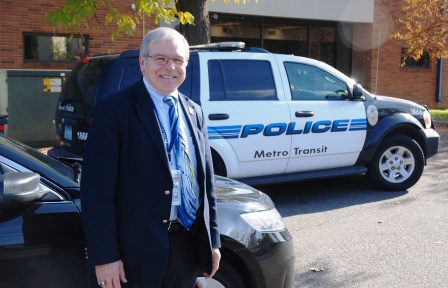 When Charles Donaldson began policing buses in 1985, he’d simply leave his downtown Minneapolis apartment, walk to the corner and hop aboard.
When Charles Donaldson began policing buses in 1985, he’d simply leave his downtown Minneapolis apartment, walk to the corner and hop aboard.
He carried no radio to keep him in touch with other officers and worked a loosely-coordinated schedule that sometimes left him working solo. Because the Metro Transit Police Department had not yet been written into state law, Donaldson carried his badge and ticket book from the Minneapolis Police Department, where he was a patrolman.
For the most part he worked overnight shifts on Thursdays, Fridays and Saturdays, patrolling the busiest local routes – including a trip to the Roller Garden skating rink in St. Louis Park popular with young people. On many occasions, he was partnered with current Police Chief John Harrington.
“Basically, we were riding around in buses, sitting in the back seat and only taking on the stuff you felt comfortable with,” Donaldson said recently. “It could be a little fearful because you could take someone off the bus and not know if help was coming or not.”
Things have improved quite a bit since then.
The Metro Transit Police Department was written into law in 1994, transforming it from a group of around 50 part-time Minneapolis and St. Paul police officers to a full-fledged force with the rights and responsibilities of other Minnesota police departments. A pair of used State Patrol vehicles and uniforms were purchased to get the new force off the ground.
“For us, it was kind of a shock to change from a security division to a police department,” Donaldson remembered. “But it was also a relief because now you had a statute to work with and more jurisdictional authority.”
Donaldson was among the first to transition from city police to a role with the newly-established police department, becoming a full-time night supervisor in 1999. At the time, the department was gearing up for the opening of the METRO Blue Line.
For Donaldson, the career move presented him with a unique opportunity to help build the fledgling department as well as a chance to work more with the public.
“This is a much more people-oriented business,” he said. “You’re not just going from call to call to call.”
Today, Donaldson is among the most tenured officers at the Metro Transit Police Department. He leads the department’s investigation division, collecting statements, searching video and assembling other evidence as he looks into operator assaults, thefts, fights and other issues. Donaldson also plays a lead in accident reconstruction.
Many of the tools now at Donaldson’s disposal were unimaginable when he began his career. Data is used to share information and establish crime trends while the introduction of security cameras provides video that can help pinpoint suspects.
The locations of all buses and trains are tracked in remote control centers that are staffed by supervisors who can be contacted by a rail or bus operator in an instant. Law enforcement can also be dispatched at a moment's notice from control centers.
“Video didn’t come around until the 90s,” Donaldson said. “The ability to pull tape has really improved things.”
Also new: a larger, more diverse force and a broad, eight-county coverage area that includes not just buses and light-rail trains but more than 100 Park & Rides and the Northstar Commuter Rail Line. After hiring its first full-time officers in 2008, the department has now expanded to 83 full-time sworn and licensed Metro Transit police officers and 60 part-time officers who speak a variety of languages.
Next year will bring another new chapter for Donaldson and his fellow officers: the opening of the METRO Green Line between downtown Minneapolis and downtown St. Paul. As part of the preparation for its opening, the department has opened a new east command center off University Avenue.
However his role changes in the future, Donaldson said his motivation will remain the same.
“The most gratifying part of this for me is talking to our customers and making sure get the resolution they need,” he said.
> New officers, new diversity for Metro Transit Police
> Metro Transit Police Department
> Help solve a crime – use TipLine